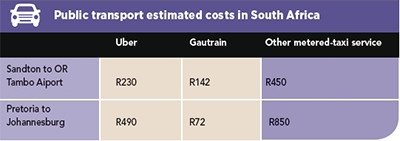
Uber has come to stand for more than just the name of the ride-hailing app. It's often bandied about by public relations officers when describing the disruptive intentions of keen startups. This is because the innovative platform quickly became one of the most valuable tech startups in the world. It created a mobile on-demand solution to a simple problem, and is now the world's largest taxi company, valued at $68 billion.
The service has taken off in South Africa, despite government red tape and driver intimidation because it is convenient and affordable. In 2014, there were over one million trips in SA taken on Uber. In the first half of 2015, there were over two million trips booked.
Uber recently held a driver-partner appreciation event, where 400 of the top Uber drivers in Gauteng were invited to listen to the company's plans for 2016.
Uber SA GM Alon Lits addressed one of the concerns about there being too many Uber cars on the road. "The more cars we have on the road, the more reliable Uber becomes and demand goes up."
He said the average wait time in and around Johannesburg is less than five minutes, which makes the app a dependable public transport system. "More cars also means there are fewer 'dead' kilometres taking place, fewer kilometres driven without a passenger in the car."
The company has now reached a point where it is skating the fi ne line between flooding the market with cars and creating opportunities for more drivers in the country.
There is a waiting list for new drivers who want to join Uber. Lits says supply and demand is constantly assessed so that the market is not flooded. Preference is given to drivers turned Uber car-owners, as opposed to people who already own fleets of cars.
Last year, Uber and Wesbank partnered to offer existing driver-partners access to a specially designed full-maintenance lease programme, giving them access to a vehicle at preferential rates.
Legislation deadlock
Government was slow to regulate the new industry created by Uber, leading to ambiguity around how the e-hailing service should be licensed. However, early this year, two years after Uber entered the market, government moved to approve a bill that will regulate the service in the country.
The new bill forms part of government amendments to the National Land Transport Act. It aims to untangle the legislation deadlock that was a result of the cities where Uber operates ? Johannesburg, Pretoria, Cape Town, Durban and Port Elizabeth ? interpreting the national licensing protocol differently.
More cars also means there are less 'dead' kilometres taking place - less kilometres driven without a passenger in the car.
Alon Lits, Uber SA
In addition to licensing issues, Uber drivers were being intimidated by other metered cab drivers who claimed Uber was stealing their business and operating illegally.
However, government's announcement that it will move to approve a bill to regulate Uber in SA means the e-hailing service can be regulated by authorities in line with other metered taxi operations.
This year, Uber plans to shorten drivers' waiting time between passengers. To this effect, the driver's side of the app has been optimised to streamline passenger pick-ups.
'Forward Dispatch' is one of the new features that got the most cheers from drivers. It allows drivers to receive a request from another rider while they are still on a trip. Previously, trips would have to end before other requests could come through. This meant drivers would have to wait around after trips and not drive directly to where they were needed.
Another way Uber hopes to minimise waiting time between passengers is by introducing a new product called UberRUSH. It works similarly to the current app, but instead of hailing a taxi for a person, users are able to hail a taxi for a parcel.
Parcels are typically delivered during the day, when Uber does not get a lot of requests for passengers. This means drivers will be able to fill their time in between the morning and afternoon rush, by delivering goods and therefore earning more money.
The product is in use in the US, and Lits says it would be a great fi t for this country. Parcel delivery via Uber is already being done informally. When asked if drivers had ever been requested to transport goods instead of people, more than half the drivers in the room raised their hands.
Looking to Africa
Lits did not give a launch date for UberRUSH in SA, but said the firm hopes to formalise it this year.
The company operates in nine cities in SA, Nigeria and Kenya. It plans to expand to Tanzania, Uganda and Ghana by the end of 2016. The company's focus will be on convincing traditional taxi drivers to work for Uber. The app will be pitched as an 'extra' to the work they are already doing. Drivers will be encouraged to carry on working on their own, but when their car is empty, they can choose to activate Uber to pick up passengers and make more money.
Uber will also have to consider alternative payment methods. It is traditionally linked to users' credit cards for cashless interactions. However, only one in every three people in Sub-Saharan Africa has a bank account, creating a challenge for the company.
Uber has experimented in Kenya with allowing riders to use mobile money or cash to pay, which Lits says has boosted growth in Nairobi. This will be part of Uber's tailored Africa strategy.
This article was first published in the May 2016 edition of ITWeb Brainstorm magazine. To read more, go to the Brainstorm website.
Share